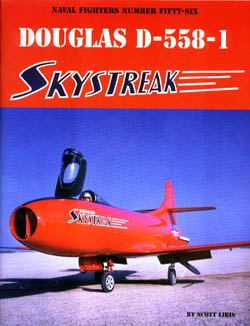 Douglas D-558-1 Skystreak Douglas D-558-1 Skystreak
Naval Fighters Number Fifty-Six
Scott Libis
Steve Ginter Books © 2001
ISBN 0-942612-56-6 This paperback title, number 56 in Steve Ginter's Naval Fighters series, was compiled and written for Steve by Scott Libis. Its 68 pages, including covers, are printed on good heavy glossy stock, upon which the three color photos, 100 black and white photos and 20 drawings are beautifully reproduced. The subject, one of the best-looking airplanes ever built, is incredibly exciting and the excitement of its testing manages to come through the author's ponderous "Engineering report - Just the facts 'mam", style of writing. For several years early in my aviation career I was, variously, a Tech Writer, Illustrator, Editor and Publisher at Boeing and I cannot, to this day, read anything, even a newspaper, without proofreading it in the process - really slows me down. This book was an especially slow read. Steve Ginter appears to have fired his proofreaders and removed Spell-Check from his computers. This thing is also full of typically stilted engineeringeze, jarringly awkward constructions, misspellings and misstatements. An egregious example is this sentence on page 20: "A new feature a variable incidence horizontal stabilizer, was incorporated into the tail, contributing much to improved longitudinal stability." It's mispunctuated, it's factually wrong - trimmable stabs date back to, at least, WWI, a trimmable stab does not contribute to longitudinal stability - it adjusts for changes in CG and other variables such as flap or speed brake deployment, and the author uses the pretentious term "horizontal stabilizer" rather than the simpler, more efficient old term "stabilizer"; and last, as the airplane was new and designed from a clean sheet of paper the incorporation of a yestertech idea like stab trim could, literally, do nothing to "improve" longitudinal stability when there was, at the time of design, no stability to improve. In a photo caption on the very next page the author says, " At right, the mechanism of the all-flying tail” Sorry laddy, an "all-flying tail" (stabilizer) has no elevator - like the late Sabres and the Phantoms, etc, etc. The Skystreak had a quite conventional tailplane - stabilizer and elevator, with the stab being trimmable, via a powerful mechanism, over a broad range. The range and power of the stab trim were the only, relatively, new features here. Three Skystreaks, also called "Flying Red Test Tubes", s/ns 43-7970, 43-7971 and 43-7972, were built for the Navy to explore the transonic speed range from about .8 Mach to about 1.2 Mach. The first plane racked up the most flights, 101, between its first flight on April 15, 1947 and its last on March 11, 1949. On August 20, 1947, in the hands of Commander Turner Caldwell, it set the World Air Speed Record at 640.663 MPH. The second plane, first flown August 15, 1947 was short lived. A compressor disc burst at low altitude and high speed on its 46th flight on May 3, 1948. The ensuing crash killed NACA test pilot, Howard Lilly, and destroyed the airplane. Prior to its loss, 37971, flown by Major Marion Carl on August 25, 1947 raised the World Air Speed Record, set five days earlier by Commander Caldwell in 37970, to 650.796 MPH. The third plane first flown on January 3, 1949 had an uneventful, but busy, life of 83 flights and was retired on June 10, 1953. The first plane is now on display at the National Museum of Naval Aviation in Pensacola, beautifully restored save for incorrectly white painted undercarriage and wheel wells. The third plane was scheduled for roll-out from restoration at the Carolinas Aviation Museum in Charlotte in June of this year. Does any reader know the status of this project? Despite my beefs about the readability of this book, I strongly recommend you buy it if you are at all interested in the era of the early "X" planes. It's full of good material for the av history buff and also full of great photos and drawings of use to the scale modeler. I wish I'd had it available in 1989 when I built my 1/72nd scale Skystreak from that pretty awful old Meikraft kit I bought my copy of the book at the IPMS-Seattle July meeting for $13.60, plus Washington State's sales tax of 8.8% from The Supply Depot. At the end of this book Lloyd Jones presents a review of each of the six Skystreak kits issued to date: Meikraft, Douglas, Mike Herril, Collect-Aire, Allyn and HBM Models. He notes that 12-Squared is planning to reissue the Meikraft kit, with all the needed corrections incorporated, sometime in 2002. Steve Ginter's two series of airplane monographs are of great value to we modelers who like unusual, odd-ball, airplanes. I do hope this volume will be followed by volumes on the Douglas D-558-2 Skyrocket, the Convair XF-92, the Douglas X-3 Stilleto, the Northrop X-4 Bantam and the Bell X-5. How about it Steve? |


 




|